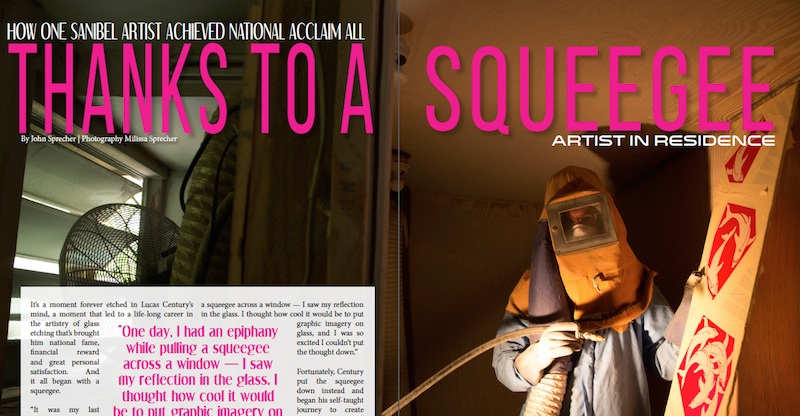It’s a moment forever etched in Lucas Century’s mind, a moment that led to a life-long career in the artistry of glass etching that’s brought him national fame, financial reward and great personal satisfaction. And it all began with a squeegee.
“It was my last summer of college,” he recalls. “I had two courses left to complete my Bachelor of Science degree, and I was washing windows to make money. One day, I had an epiphany while pulling a squeegee across a window — I saw my reflection in the glass. I thought how cool it would be to put graphic imagery on glass, and I was so excited I couldn’t put the thought down.”
Fortunately, Century put the squeegee down instead and began his self-taught journey to create what was then an entirely new art form: photo stencil sandblasting. With samples in hand, he began knocking on doors of architects and designers in Cleveland, who found his technique — one that employed etching onto building materials — novel, interesting and attractive. Ultimately, he landed an assignment and off his career took.
View this story in our digital magazine beginning page 9.
To hear Century describe the processes he uses to create his art sounds much more like science. “Basically, I’m creating a mask that protects the surface of the glass, stone or tile. It’s created photo-mechanically, utilizing an elastomeric substance affixed to the substrates. One might be liquid coated directly, or a prefabricated stencil that can bond to a vertical surface. Essentially, it’s a transfer and the etching or engraving happens after.”
Over his career, Century has applied his creative talents to a variety of materials in a variety of sizes — large stone murals (10 feet by 30 feet, such as Florida Gulf Coast University), elevator shafts, paper weights, vases, even drinking glasses. The work can be commissioned (like public art or donor walls) or self-produced (such as his line of wildlife artwork found in gift stores). His art sells for as little as $50, or up to $150,000. “I like the idea of decorating the world,” he says, “and to do that, I need to make some of it affordable.”
Being affordable also led to his most famous work of art, one that got him the nickname “the guy who did the wall.” It was the early 1980s, and discussion of the Vietnam Veterans Memorial Wall put the timeline to complete the 58,000-names project at three years and the cost in the millions of dollars. But Century had a different idea — his prefabricated stencil that bonds to a vertical surface — and when he met with the director of the project, showed him prototypes and promised it would take only months and hundreds of thousands of dollars to do the job, “he about fell out of his chair. They really felt like I was a Godsend and for me, it was a Godsend to work on that project. I had achieved probably the ultimate in an engraver’s career and I was just in my mid-20s. I knew it was my opportunity to create this as my life’s work.”
His full time relocation to Sanibel occurred in 1985. Two years earlier, on a brief hiatus to Captiva Island, Lucas was enjoying some live music at the Crow’s Nest at ‘Tween Waters Inn when he met a woman named Dee on the dance floor — and it was love at first shimmy. “We bought our cottage that year, and we’re still in it today. It’s provided the space for my work and for Dee’s garden, as well as our short trips to the beach. It’s just been marvelous.”
Reflecting (pun intended) on his art, Century explains he works mostly in glass “because I love the transparency and reflective quality. Clear glass captures the light in a brilliant manner, and allows the rest of the environment to work around it. I hope my art gives everyone a sense of clarity.”
239-472-4496
By John Sprecher

